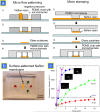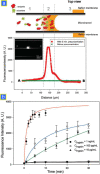Nanofluidic concentration devices for biomolecules utilizing ion concentration polarization: theory, fabrication, and applications
- PMID: 20179814
- PMCID: PMC2929016
- DOI: 10.1039/b822556g
Nanofluidic concentration devices for biomolecules utilizing ion concentration polarization: theory, fabrication, and applications
Abstract
Recently, a new type of electrokinetic concentration devices has been developed in a microfluidic chip format, which allows efficient trapping and concentration of biomolecules by utilizing ion concentration polarization near nanofluidic structures. These devices have drawn much attention not only due to their potential application in biomolecule sensing, but also due to the rich scientific content related to ion concentration polarization, the underlying physical phenomenon for the operation of these electrokinetic concentration devices. This tutorial review provides an introduction to the scientific and engineering advances achieved, in-depth discussion about several interesting applications of these unique concentration devices, and their current limitations and challenges.
Figures










Similar articles
-
High-performance bioanalysis based on ion concentration polarization of micro-/nanofluidic devices.Anal Bioanal Chem. 2019 Jul;411(18):4007-4016. doi: 10.1007/s00216-019-01756-8. Epub 2019 Apr 10. Anal Bioanal Chem. 2019. PMID: 30972474 Review.
-
Nanofluidic Lab-On-A-Chip Systems for Biosensing in Healthcare.Small. 2025 Jan;21(1):e2407478. doi: 10.1002/smll.202407478. Epub 2024 Nov 3. Small. 2025. PMID: 39491535 Review.
-
Nanofluidic technology for biomolecule applications: a critical review.Lab Chip. 2010 Apr 21;10(8):957-85. doi: 10.1039/b917759k. Epub 2010 Feb 23. Lab Chip. 2010. PMID: 20358103 Review.
-
A review of nanofluidic patents.Recent Pat Nanotechnol. 2008;2(3):150-9. doi: 10.2174/187221008786369633. Recent Pat Nanotechnol. 2008. PMID: 19076049 Review.
-
Decreasing effective nanofluidic filter size by modulating electrical double layers: separation enhancement in microfabricated nanofluidic filters.Electrophoresis. 2008 Dec;29(23):4646-51. doi: 10.1002/elps.200800256. Electrophoresis. 2008. PMID: 19016242
Cited by
-
Enhanced Salt Removal by Unipolar Ion Conduction in Ion Concentration Polarization Desalination.Sci Rep. 2016 May 9;6:25349. doi: 10.1038/srep25349. Sci Rep. 2016. PMID: 27158057 Free PMC article.
-
Effect of channel geometry on ion-concentration polarization-based preconcentration and desalination.Biomicrofluidics. 2019 Nov 1;13(6):064102. doi: 10.1063/1.5124787. eCollection 2019 Nov. Biomicrofluidics. 2019. PMID: 31700561 Free PMC article.
-
Quantification of Vortex Generation Due to Non-Equilibrium Electrokinetics at the Micro/Nanochannel Interface: Particle Tracking Velocimetry.Micromachines (Basel). 2016 Jul 21;7(7):127. doi: 10.3390/mi7070127. Micromachines (Basel). 2016. PMID: 30404299 Free PMC article.
-
Ion Transport in Electromembrane Systems under the Passage of Direct Current: 1D Modelling Approaches.Membranes (Basel). 2023 Apr 8;13(4):421. doi: 10.3390/membranes13040421. Membranes (Basel). 2023. PMID: 37103848 Free PMC article.
-
Electroconvective viscous fingering in a single polyelectrolyte fluid on a charge selective surface.Nat Commun. 2023 Nov 17;14(1):7455. doi: 10.1038/s41467-023-43082-9. Nat Commun. 2023. PMID: 37978170 Free PMC article.
References
-
- Singh AK, Throckmorton DJ, Kirby BJ, Thompson AP. Micro Total Analysis Systems. Vol. 1. Kluwer Academic; Nara, Japan: 2002. pp. 347–349.
-
- Foote RS, Khandurina J, Jacobson SC, Ramsey JM. Anal. Chem. 2005;77:57–63. - PubMed
-
- Wang Y-C, Stevens AL, Han J. Anal. Chem. 2005;77:4293–4299. - PubMed
-
- Lichtenberg J, Verpoorte E, Rooij N. F. d. Electrophoresis. 2001;22:258–271. - PubMed
-
- Cui H, Horiuchi K, Dutta P, Ivory CF. Anal. Chem. 2005;77:7878–7886. - PubMed
Publication types
MeSH terms
Grants and funding
LinkOut - more resources
Full Text Sources
Other Literature Sources

